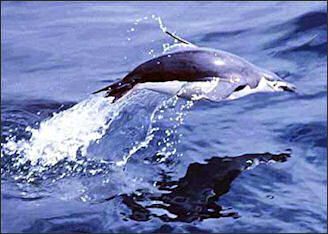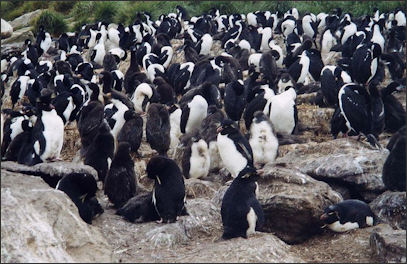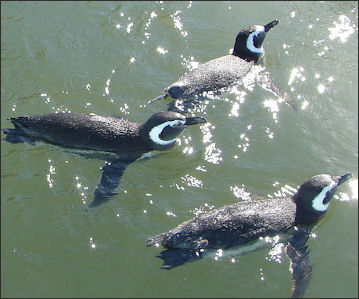PENGUIN BEHAVIOR
 Penguins are very social animals. They often hang out in groups. In the mating season they live in large colonies. Penguin colonies are quite smelly, from urine and guano and regurgitated baby food.
Penguins are very social animals. They often hang out in groups. In the mating season they live in large colonies. Penguin colonies are quite smelly, from urine and guano and regurgitated baby food.
According to Animal Diversity Web: Some species forage cooperatively and may dive synchronously while foraging in small or large groups. Species that breed in large colonies often have elaborate visual and vocal displays. Vocalizations are characterized as loud, short braying. Among colonial species in which chicks group together in a nursery (or crèche) recognition of mates and offspring seems based on individually distinguishable calls. [Source: Laura Howard, Animal Diversity Web (ADW).
Bird guru Roger Tory Peterson has said that penguins remind him of humans: "There is constant bickering — constant greeting, protest and challenge. There is love (but no privacy). There is thievery, as when one penguin steal's another's stones to build a nest, and even juvenile delinquency when unmated two or three year olds clumsily take over unguarded nests and chicks, which they may not properly care for." Penguins enjoy being touched. In the winter they stay warm by huddling together.
RELATED ARTICLES:
SEA BIRDS: TYPES, MIGRATIONS AND THREATS ioa.factsanddetails.com ;
PENGUINS: CHARACTERISTICS, HISTORY AND SWIMMING ioa.factsanddetails.com ;
ENDANGERED PENGUINS: DECLINING NUMBERS, THREATS ioa.factsanddetails.com ;
EMPEROR PENGUINS: CHARACTERISTICS, BEHAVIOR, SWIMMING ioa.factsanddetails.com
NEW ZEALAND PENGUINS: SPECIES, HISTORY, CHARACTERISTICS, BEHAVIOR, REPRODUCTION ioa.factsanddetails.com
LITTLE PENGUINS: CHARACTERISTICS, BEHAVIOR AND REPRODUCTION ioa.factsanddetails.com
Websites and Resources: Animal Diversity Web (ADW) animaldiversity.org; National Oceanic and Atmospheric Administration (NOAA) noaa.gov; Encyclopedia of Life eol.org; Smithsonian Oceans Portal ocean.si.edu/ocean-life-ecosystems ; MarineBio marinebio.org/oceans/creatures
Penguins Don’t Topple Over Watching Planes
According to an "urban" myth penguins look upwards at planes and helicopters and follow them until the fall backwards. In 1982, British Royal Air Force (RAF) pilots first reported seeing penguins falling over during the Falklands War with Argentina. The story caught the imagination of British newspapers, and one tabloid even published a drawing showing a penguin in various stages of falling.
A team of British scientists traveled to the Falklands Islands in 2001 to study of the phenomena and found it was not true. Associated Press reported: Penguins are more sensible than we thought. When an aircraft flies overhead, they do not topple over like dominos, as some Royal Air Force pilots have reported. A scientist who recently watched king penguins react to aircraft said that the birds do the practical thing: shut up and try to get away from the noise. "Not one king penguin fell over when the helicopters came over Antarctic Bay," said Richard Stone of the British Antarctic Survey. [Source: Associated Press February 1, 2001]
“The claim that penguins fell over backwards while gawping at aircraft got world-wide exposure in 2000, following a report in a London newspaper. Stone went to the remote sub-Antarctic island of South Georgia in December to study how the penguins reacted to British Lynx helicopters. He compared the actions of a breeding colony at Antarctic Bay, where Royal Navy aircraft flew over, with another at Possession Bay where there were no overflights. "As the aircraft approached, the birds went quiet and stopped calling to each other, and adolescent birds that were not associated with nests began walking away from the noise," he said in an interview. "Pure animal instinct, really." What was more, Stone said, the birds resumed their normal behaviour within minutes, "usually by the time the helicopter was out of audible range". Breeding adults stayed by their nests and he observed no egg or chick losses.
Stone also noted that during the experimental period, the number of incubating birds in the colony increased at the same rate as that of an undisturbed control colony at nearby Possession Bay. He concluded that flights over 1, 000 feet caused "only minor and transitory ecological effects" on king penguins. Stone said he will now conduct a computer analysis of videos he made of more than 100 penguins using four video cameras. "It may be that there have been changes to the birds' behaviour that we didn't notice before," he said.
South Georgia is an important habitat for wildlife and is home to large colonies of seals, penguins and seabirds, including about 400 000 pairs of breeding King penguins. There are about 700 pairs at Antarctic Bay and 400 pairs at Possession Bay.
Penguins Identify Mates and Kin by Smell

rockhopper rookery In September 2011 Reuters reported: “Penguins can sniff out the odor of lifelong mates, helping them reunite in crowded colonies, and also can identify the scent of close kin to avoid inbreeding, scientists said on Wednesday. Some seabirds have previously been known to use their sense of smell to find food or locate nesting sites but the experiments with captive Humboldt Penguins at Brookfield Zoo near Chicago proved, for the first time, that the birds use scent to discriminate between close relatives and strangers. [Source: Andrew Stern, Reuters, September 21, 2011]
"Other animals do it, we do it, so why can't birds?" said Jill Mateo, a biopsychologist at the University of Chicago, who worked with graduate student Heather Coffin on the research published in the journal PLoS ONE. "Their sense of smell can help them find their mates and perhaps choose their mates," Mateo said."Seafaring birds that travel long distances in the ocean use odors to find food and use odors to recognize nests but we didn't know what odors or the extent to which they could use odors to recognize kin," Mateo said. "This was the first study to show they can use odor to recognize genetic differences," she said.
Researchers worked with two groups of endangered Humboldt Penguins raised at the zoo, totaling 22 birds. Their behavior was recorded as the birds examined scents emitted by oil from the birds' preening glands. The gland near the bird's tail excretes oil used to keep them clean but also has an olfactory purpose.In one experiment, penguins with mates preferred the comfort of their mates' scent over the scents of unfamiliar penguins. In another, penguins without mates spent twice as long investigating unfamiliar penguins' scents than those belonging to their close relatives.
"In all sorts of animals that we study, including human babies, novel odors, novel cues, are investigated longer than less-novel cues," Mateo said Scent is used by many species to attract mates, or to avoid mating with relatives, she said. For Humboldt penguins, which nest on Peruvian cliffs and spend long periods foraging at sea, odor acts as an identifier when they return to colonies crowded with thousands of birds nesting in cracks and crevices.
"It's important for birds that live in large groups in the wild, like penguins, to know who their neighbors are so that they can find their nesting areas and also, through experience, know how to get along with the birds nearby," said animal behavior expert Dr. Jason Watters of the Chicago Zoological Society, which operates Brookfield Zoo. "It could also be true that birds may be able to help zoo matchmakers in determining potential mates," Watters said. "You could imagine that if (naturalists) were trying to reintroduce birds to an area, you could first treat the area with an odor the birds were familiar with. That would make them more likely to stay," he said.
Penguin Mating and Prostitution

Penguins are considered monogamous and individuals often nest at the same nest site, with the same partner from the previous year. In some species, 13 year pairings have been observed. Courtship displays are varied and complex, and may include loud raucous vocalizations, 'mutual ecstatic displays'(mate recognition behaviors), and beak slapping (or bill-fencing displays). [Source: Laura Howard, Animal Diversity Web (ADW)
Telling males and females apart is very difficult. Even penguins it seems sometimes have difficultly making the distinction. Sometimes a male confronted with another penguin determines the sex of the stranger by picking up a pebble and dropping it in front the penguin whose sex they are trying to figure out. If the stranger picks a fight the pebbledropper knows it male. If it shows indifference then he knows it’s a female. If the female shows interest in the male the male may bow, then the two penguins stretch out wings and their necks and make a loud celebratory call and mate.
Some penguins get "divorced". Magellanic penguin expert Dee Boersma told the New York Times, “When we do our census, we find individuals with mates other than those they had the year before — and they are living within meters of their mates. That’s more likely to happen by the way, if the couple has failed at raising a chick; they’ll move to another mate...And yet, we find other pairs with great fidelity. We have one pair that stayed together for 16 years. What’s really interesting is that if the penguin keep the same mate, they raise more chicks. Fidelity gives them great evolutionary success.”
Adelaide penguins are largely monogamous but sometimes they engage in a form of prostitution. These birds make their nests from rocks. Sometimes there are so many penguins at a given nesting site that supplies of rocks run short. Females sometimes offer to have sex with males who have accumulated large piles or rocks in return for some of their stones.
Gay Penguins
Some species of penguins form life-long same sex pairs, especially in captivity. A pair at a zoo in New York incubated rocks together until their keepers gave them an egg. The revelation turned out to be an embarrassment to conservative Christians in United States that trumpeted penguins in the film “March of the Penguins” as paragons of family values.The unions are at least partly attributed to difficulty in finding opposite sex partners among the small groups of penguins in zoos and aquariums.
Gay penguins of either sex are not usual and are found both in the wild and in captivity. Those at London Zoo have participated in the city's Pride event. Oceanworld Aquarium in Ireland even has a gay penguin majority, with eight out of its 14 gentoo penguins coupled up with a partner of the same sex. [Source: BBC, August 12, 2019 **]
In July 2019, two male penguins at the Berlin Zoo began caring for an abandoned egg in what was described as “their long quest to become parents.” “The same-sex couple, Skipper and Ping, are keen to have a chick of their own, and have even been known to "try to hatch fish and stones", spokesman Maximilian Jäger told the Berliner Zeitung newspaper. He said the two king penguins adopted the egg, which had been abandoned by the sole female of the species at the zoo, and are "behaving like model parents, taking turns to keep the egg warm" by nestling it on their feet under a flap of belly skin. “They are now doing their best to protect their precious charge from jealous rivals, after a little encouragement from their human guardians. "We just had to put it on the feet of one of the guys, and he already knew what to do," says zookeeper Norbert Zahmel. “The female in the group of six king penguins has shown little interest in her eggs recently, and the zoo hasn't had a chick since 2002."A successful hatching would be great," Mr Zahmel told the BZ tabloid. “The 10-year-old pair moved to Berlin from Hamburg's Hagenbeck Zoo in April, and have been inseparable ever since. **
In 2011, one member of a same-sex penguin pair at the Toronto Zoo found a female partner. Associated Press reported: It appears a female has come between one of Canada's celebrity couples. Toronto's zoo split up a pair of male penguins whose affection for each other drew headlines and jokes about "Brokeback Iceberg." The zoo said that Buddy and Pedro have been officially separated and Buddy has mated with a female. Pedro has yet to get lucky, but officials say it's not for a lack of trying. The birds' separation was one zoo officials said was necessary because penguins are an endangered species and the two needed to mate with females. The African penguins had shared the nest they built since coming to the zoo about a year ago. [Source: Associated Press, December 12, 2011 ++]
Curator Tom Mason describes their bond as social — not sexual — and says when the birds rejoin the general population, they are likely to stay with their female matches go their separate ways. The story of the pair, who came to be known as Toronto's "gay penguins," went viral online, leading to cheeky YouTube videos. Late-night TV comics jumped into the icy waters of penguin passion. Jimmy Kimmel riffed on the story during a recent monologue, calling it "Brokeback Iceberg" and claiming the lovebirds were spotted at a Lady Gaga concert Buddy, who is 21, had a female mate for 10 years and produced some offspring before his partner died. Pedro, 10, has yet to produce any offspring. ++
Penguins Colonies

Magellanic Penguin adult and 2 chicks Most penguins breed in large colonies. Some are huge. One of the largest is the Macaroni penguin colony in South Georgia, which is estimated to have five million pairs.
Nesting areas are diverse and include small caves, burrows, coastal forests, and pack ice.The Pinguinerias of Patagonia contain some of the largest penguins colonies in the world. At PuntoTombo there is literally over a million Magellanic penguins scattered on the shores and barren hills. The breeding season is September to March. Between December and January the young penguins are taken to the sea for the first time. During the March access to Punto Tombo is sometimes restricted as the birds prepare to migrate. Unlike their slick black-and-white tuxedoed parents, the chicks are covered with soft grey down and feathers.
Parents recognize their chicks out of the multitude when they return with food by the distinctive calls the chicks make. The sounds made by different chicks appear to sound very different to penguins even though they sound the same to humans. Although penguins may look and sound all alike to us, experiments with penguins and tape recorders have shown penguins can instantly recognize their mates and chicks by sound .
Penguins Nesting
Penguins build minimal nests. Some make burrows. Both the male and female help take care of the of the eggs and young. Parents of many species spend much of their time away from the nest gathering food. The chicks are fed fish caught by their parents and regurgitated into their mouths.
According to Animal Diversity Web: Antarctic, sub-Arctic and cold temperate penguins breed in either spring or summer, whereas species in warmer climes have more continuous breeding seasons. Penguin nests range from shallow dishes of pebbles and vegetation, to holes dug in soft soil, to rocky depressions, to the space between the top of the feet and the pouch-like fold of abdominal skin. Females lay one to two whitish eggs per clutch, with two to four days between egg laying. [Source: Laura Howard, Animal Diversity Web (ADW)]
According to Animal Diversity Web (ADW) Incubation, brooding, and feeding-fasting cycles are diverse and complex. Some species begin fasting at the onset of the breeding season. In some species males and females share incubation, whereas in others incubation is primarily uniparental. Incubation duration ranges from 30-64 days, whereas parental incubation shifts may range from 5-64 days. Usually the male takes the first incubation shift after the female has laid the clutch. One of the longest incubation and fasting shifts occurs in the Emperor penguin. During the Antarctic winter, the female Emperor penguin lays one egg then departs to feed at sea. The male fasts while incubating for 60 days till the female returns at hatching time. At that point the female begins brood care while the male goes to feed at sea. Contrastingly, during the Antarctic summer the female Chinstrap penguin lays two eggs. The female then fasts while incubating for 30 days until the male returns from feeding at sea. [Source: Laura Howard, Animal Diversity Web (ADW)]
Penguin Young
Many penguin species lay two eggs. According to Animal Diversity Web: Hatching may be synchronous or asynchronous (one or two days apart). Often the younger of two chicks will not survive. Chicks are altricial (born relatively helpless and in need of significant parental care) and take 10-52 weeks to fledge. In some species chicks remain with and are regularly fed by adults until fledged. In other species the chicks may be fed till nearly adult size, then fast for several months while huddling with other chicks for warmth in a nursery. Average age of first reproduction differs between species, ranging from two to five years old. Life expectancy from fledging may be 20 years. Chicks have two nestling downs.[Source: Laura Howard, Animal Diversity Web (ADW)

Adelie Penguins
Penguin chicks don't have the smooth streamlined bodies of their parents. They are odd looking bundled of baby fat and fur-like down. Many fall victim to swooping birds of prey such as skuas who grab the chicks while the parents are hunting at sea.
Each incubating penguin holds an egg on top of it feet and incubates it with its body. Adelie penguin parents simply abandon their young after a certain period of time. After the chicks get hungry enough they make their way to sea and dive in and begun hunting for krill.
Image Sources: Wikimedia Commons, NOAA
Text Sources: Animal Diversity Web (ADW) animaldiversity.org; National Oceanic and Atmospheric Administration (NOAA) noaa.gov; Wikipedia, National Geographic, Live Science, BBC, Smithsonian, New York Times, Washington Post, Los Angeles Times, The New Yorker, Reuters, Associated Press, Lonely Planet Guides and various books and other publications.
Last Updated May 2023
